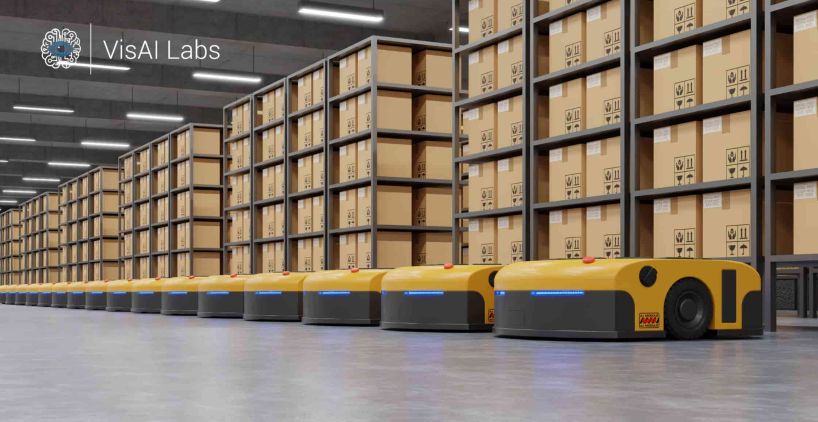Summary
According to a recent poll, eCommerce retail revenues are expected to soar from 14.1 % to 22 % by 2023 due to exponential growth in online shopping.
Warehouses and distribution centres worldwide are introducing automated dimensioning technologies to maximise efficiencies to keep up with this demand and bring deliveries out the door quicker.
This blog will provide you with nine expensive tips for enhancing warehouse performance with automated dimensioning systems.
Written for:
- Warehouse Automation Manager:
Understanding how artificial intelligence (AI) is transforming warehouses and how it can make their jobs easier.
- Logistics Specialist:
Collaborate with suppliers and customers to complete last-mile delivery, understanding the Supply Chain and Logistics industry trends and the impact of AI in their core domain.
- Operations Specialist:
Ensuring that procedures and repetitive functions are to keep the warehouse running safely and effectively. Concentrate on raising efficiency by automation and bettering business processes.
Introduction
A productive warehouse maximises capacity, streamlines processes, and promotes worker productivity. As a factory runs smoothly, consumers receive their orders on schedule, and the company’s bottom line remains secure. To build a thriving organisation, you need to accumulate precise dimensioning information, and it cannot easily be accomplished with a tape and a ruler. By deploying an appropriate automated dimensioning system in the warehouse and fulfilment centre, we can replace the traditional dimensioning approach and conserve a lot of time and money.
Nine expensive tips for boosting warehouse performance with automated dimensioning systems
When a warehouse routinely provides on-time and timely shipments to customers, there are still organisational changes that can advance a warehouse’s efficiency. A traditional warehouse has much work going on at any one time, which means there’s still a need for quality improvements. Below are the nine costly tips to boost warehouse performance with automated dimensioning systems.
Space planning and design:
when an organisation decides to expand, it always looks for additional or new facilities, and this means the storage designer should involve a deep knowledge of the type of space they need to store a product, analyse the size and weight of the products, and how each product is stored, either kept on a pallet or separately? The responses will determine everything from the configuration of the facility’s picking and packaging areas to the amount of storage that will be used.
Storage space:
Storage is an imperative asset of eCommerce warehouses and distribution centres. Organisations that have good dimensional data will make the most of their storage capacity. After weighing and measuring stock-keeping units (SKUs), the product profiles can be recorded to a warehouse management system (WMS) to determine each product’s best storage position and location. This assists save space in the distribution centres, but it also means that the SKUs can fit in their designated areas.
Slotting:
The method of allocating products to warehouse locations based on organisation rules and product attributes is known as slotting. After the product measurements have been captured, they are imported into the slotting applications. Then we can utilise that information to determine how to arrange products within the pick zones to maximise order fulfilment.
Picking:
Dimensional data can be decisive in avoiding carton sorting errors in operations. Warehouse pickers are often left to make educated assumptions about what size carton to use, which can be expensive. If the package is too big, the corporation will pay to transport it by air. If the box is too thin, the packer must remove the goods and repack them, which can cause throughput disruption. Dimensional data can assist in guaranteeing that the proper size carton is used.
Validation:
The weight of an SKU will be utilised to validate picking until product information has been collected and uploaded to the WMS software. The WMS assesses how much each order will weigh as soon as it is shipped, based on the weight of the carton itself and each item it carries. Following the assembly of the order, the carton is weighed—often using an in-line scale on a conveyor system. The carton should be put aside for further examination if the actual weight varies from the estimated weight. Hand-operated order validation may be eliminated with automated verification, resulting in saving significant time and labour.
Packing:
Organisations can benefit significantly from dimensional data when it comes to package optimisation. Shipping products in big cartons filled with filler will result in waste and inefficiency, and it happens pretty often than you would expect. In operations that use standard-sized cartons, dimensional information may also support packaging optimisation. The dimensional information is used in computer-assisted carton picking and how many void fill and other packaging materials to use.
Pallet construction:
When it comes to designing secure pallets, dimensional details can be beneficial. Once the dimensional data is uploaded in the WMS software, the device will decide how objects can be placed on the pallet to maintain load consistency – typically for larger and heavier items on the bottom.
Building a load:
Not only can dimensional and weight data aid in the construction of pallets, but it can also assist in constructing trailers and other conveyance weights. Suppose an operation is transporting complete pallets, cases, irregularly formed goods, or a combination of any of the above. In that case, the dimensional data is recorded into shipping, warehousing, or load building applications, which decides how to load the truck to maximise room while remaining within weight limits.
Shipping:
The introduction of dim weight pricing has altered parcel shipping’s economics, but robust dimensional data will aid shippers to prevent expensive mistakes. A shipper tendering a comprehensive, low-density package must decide both the package’s actual weight and its dimensional weight under the carriers’ dim weight rules. The freight fee is measured accordingly if the dimensional weight is greater than the actual weight. Shippers can ensure they’re rating their parcels precisely to prevent parcel chargebacks by collecting accurate dimensional details on their deliveries.
Conclusion
When products roll out on time and customers are happy, it’s easy to assume a company is efficient. Still, it’s incredible how many minor tweaks can positively impact an organisation’s bottom line. Good warehouse efficiency is not only about putting everything in its place and getting products out on time; and it’s about maximising productivity while saving time and money.
Accelerate your warehouse throughput with vMeasure Parcel Pro – Automated dimensioning system
When estimating incoming and outgoing freight by hand, inaccuracies and transposition errors are typical pitfalls. Understanding this, VisAI Labs has built an automated static dimensioning system for scratch to calibrate the dimensional information of parcels in a jiff. This vMeasure automated dimensioning solution comes in two types: parcel dimensioner and pallet dimensioner. We focus on aiding warehouse, logistics, distribution, and order fulfilment centres with these automated dimensioning solutions.




